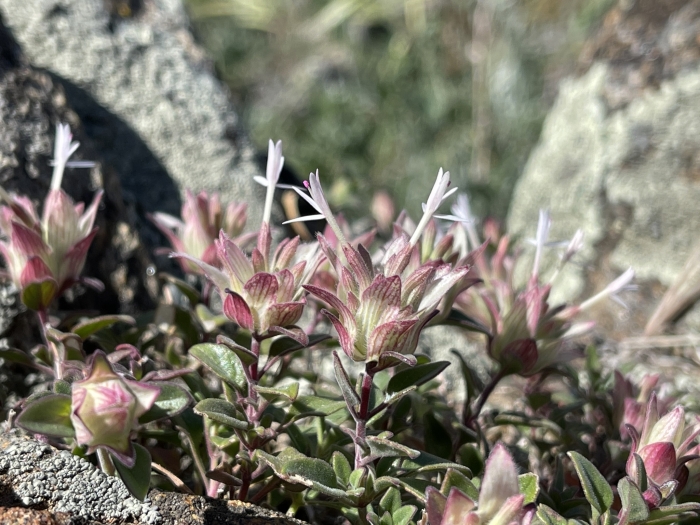Little Coyote Mint
(Monardella nana)
Little Coyote Mint (Monardella nana)
/
/

Dee Shea Himes
CC BY 4.0
Image By:
Dee Shea Himes
Recorded By:
Copyright:
CC BY 4.0
Copyright Notice:
Photo by: Dee Shea Himes | License Type: CC BY 4.0 | License URL: http://creativecommons.org/licenses/by/4.0/ | Rights Holder: Dee Shea Himes | Publisher: iNaturalist | Date Created: 2022-05-25T22:04:58Z |

























Estimated Native Range
Summary
Monardella nana, commonly known as Little Coyote Mint or Dwarf Monardella, is a rhizomatous perennial herb native to the chaparral and mountain forests of the Peninsular Ranges in southern California and northern Baja California. It typically forms a tufted mat of slender stems ranging from 10 to 30 centimeters tall, with leaves that are hairy to hairless and oval-shaped. The inflorescence is a head of white to pale pink tubular flowers, each surrounded by a cup of pink-tinged white bracts, which bloom from late spring to early summer. The flowers are modestly showy and attract pollinators such as bees and butterflies.
Little Coyote Mint is valued for its drought tolerance and its ability to thrive in poor, rocky soils, making it an excellent choice for rock gardens, native plant gardens, and restoration projects. It requires minimal maintenance once established and is best suited for full sun to part shade conditions. It is also used in traditional medicine by indigenous peoples. While it is not commonly afflicted by diseases, it can suffer from root rot if overwatered or planted in poorly draining soils. Little Coyote Mint is not known for being invasive and does not typically pose problems with aggressive roots or spreading beyond its intended area.CC BY-SA 4.0
Little Coyote Mint is valued for its drought tolerance and its ability to thrive in poor, rocky soils, making it an excellent choice for rock gardens, native plant gardens, and restoration projects. It requires minimal maintenance once established and is best suited for full sun to part shade conditions. It is also used in traditional medicine by indigenous peoples. While it is not commonly afflicted by diseases, it can suffer from root rot if overwatered or planted in poorly draining soils. Little Coyote Mint is not known for being invasive and does not typically pose problems with aggressive roots or spreading beyond its intended area.CC BY-SA 4.0
Plant Description
- Plant Type: Shrub, Herb
- Height: 0.5-1 feet
- Width: 0.5-1 feet
- Growth Rate: Moderate
- Flower Color: Pink, White
- Flowering Season: Spring, Summer
- Leaf Retention: Deciduous
Growth Requirements
- Sun: Full Sun, Part Shade
- Water: Low
- Drainage: Medium, Fast
Common Uses
Bee Garden, Butterfly Garden, Fragrant, Low Maintenance, Rock Garden
Natural Habitat
Native to chaparral and mountain forests within the Peninsular Ranges
Other Names
Common Names: Dwarf Coyote Mint, Dwarf Monardella
Scientific Names: , Monardella nana, Madronella nana, Monardella macrantha subsp. nana, Monardella macrantha var. nana,
GBIF Accepted Name: